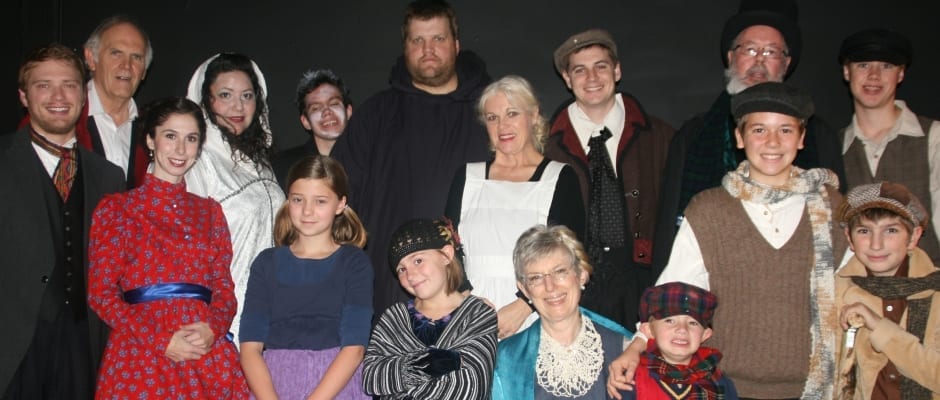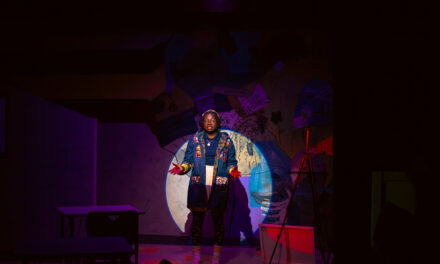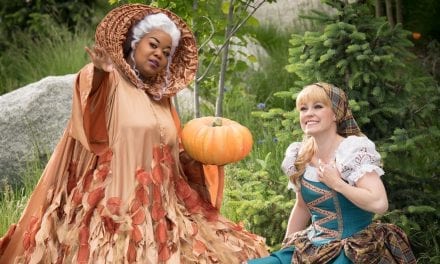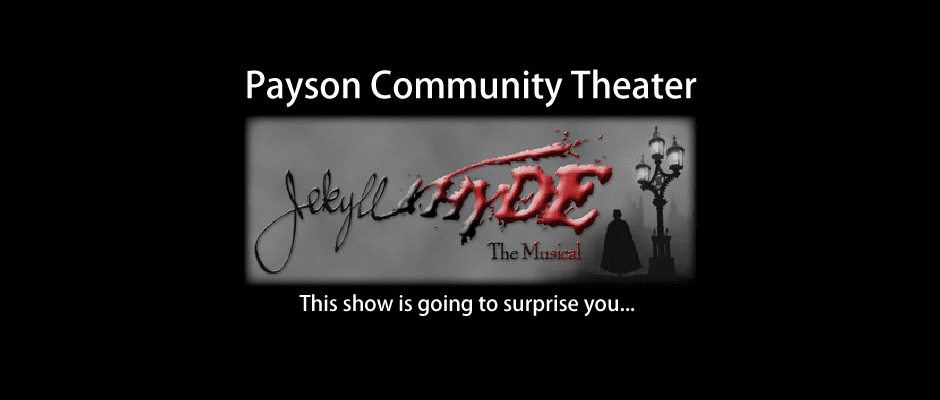SPRINGVILLE — Throughout the annals of literature, there have been few texts more influential than Charles Dickens’ immortal classic, A Christmas Carol. Originally published in the Christmas season of 1843, this insightful tale has permeated popular culture to the highest levels. Themes and storylines from A Christmas Carol can be found, re-imagined in countless stories from nearly every culture worldwide. It’s truly a story of simple, eternal truth.
This was my first experience at the Little Brown Theater in Springville. The theater is a converted office space, which makes for tight quarters. There are some physical limitations of this location that are difficult to overcome and have intense impact on the aesthetics of an evening there. As I prefer to focus on the theatergoers overall experience in my reviews, I would be remiss to not point a few out glaring flaws with the facilities. Separating the front of house and the backstage areas from the theater portion of the space are only thin curtains. I found myself yearning for a wall or two to muffle noise and keep that fourth wall intact. Also, as my 5-year-old daughter was my date for the evening, intermission meant a trip to the restroom, which sadly necessitated a walk through the actors’ area. We saw the cast of characters sitting, joking, half in costume, and complaining. I thought this was quite destructive to the illusion of the production to a young mind. I absolutely understand the limitations imposed by the space, but I would have loved to see the cast remain in character while audience members were present. That aside, I feel that this small company of players is doing the best they can with meager circumstances.
When we arrive, we have no difficulty getting our seats. In fact, we were the first there. Owing to the fact that this was but 15 minutes before the proverbial curtain was set to rise, I was nervous that this was to be a very intimate evening of theater. I was quite relieved, as we got closer to show time and a number of other audience members arrived. As we near the planned start time of 7:30, a small group of players, clad in 1850’s attire trot out, sit down and begin a discussion about carols they ought to sing. I was a little confused at this in the beginning, but soon caught on to the gimmick. This troupe actually set a nice tone for the evening. After four songs, they retired backstage and the intrepid director, Cara Baker, took to the stage for the introduction. After her brief thanks, the show begins and we’re shown the layout for the evening ahead.
A narrator in the form of a goodly grandmother, played by Lora Beth Brown, surrounded by little children will be laying out the details of the tale we’ll hear tonight. Brown’s ability and natural inflection is that of a well-weathered storyteller. Certainly, hers is a voice that has carried many a child to sleep over the years. The children at her side are adorable and I’m drawn to this method of narration immediately. The scene transitions to live action and we’re introduced to Scrooge and Cratchit, in their dank counting house. Right away I note that Bill Brown, portraying Scrooge, is having a very difficult time remembering his lines. He is tripping over phrases and saying entire lines out of order, then repeating them in the proper place. This unfamiliarity leads to a cardboard, static and uncomfortable character – not the miserly, confident skinflint that we’re all so familiar with. Sadly, this is a theme that continued on throughout the entire evening. Brown certainly looked the part, but I found his portrayal to be extremely flat and disinterested. I could actually see him waiting for his next chance to speak, instead of listening to and reacting to the business with his fellow performers.
Baker chose (wisely, given the limited space) to utilize the same performers to present numerous characters throughout the show. Mont Connell plays Bob Cratchit, Dick and “Gentlemen.” I found him to be by far most effective as Dick, Scrooge’s old co-worker. He had an easy, light-hearted air that was effective for that role. As Cratchit, I was underwhelmed with Connell’s performance. I didn’t feel that he adequately captured the gravity of vital moments in the script. During the evening, we’re next introduced to Eric Ramaekers who will be filling the shoes of Fred – Scrooge’s plucky nephew, Young Scrooge and Joe – the “businessman” who purchases Scrooge’s personal effects. Ramaekers was certainly one of the stronger players; particularly as Joe. He stank of smarmy, greasy evil during those moments and it was quite enjoyable to watch.
Adam Cannon and Craig Mustoe next enter as a pair of social workers seeking donations to help the poor. Mustoe seemed very uneasy on stage and it lead to very poor choices; namely, he spent most of his first scene with his back full on to the audience. He later portrayed the role of Fezziwig, opposite his actual wife (Jennifer Mustoe), and settled into that role much better. Cannon brings us both the Ghost of Christmas Present and the Ghost of Christmas Future. He shines as the larger than life, chuckling Ghost of Christmas Present. Casting Cannon as the Ghost of Christmas Present was a near-perfect decision. The Ghost of Marley is played by a young man named Gabriel Nicholas. The choice was made for him to constantly pace throughout the scene. I respect that the story calls for Marley to never rest, but I felt this lead to blocking choices that were difficult to watch. He lacked motivation in his many vocal outbursts, but was very committed to them.
As the show progressed I noticed another disheartening trend, in that the narrator would be reading the story while the actors were performing those events, but they wouldn’t match up. Just little things that would have been quite easily remedied; such as a nightcap being specifically called for, but not physically manifest. Also, emotional connections spoken out by the reader but completely lost on the performers – Scrooge in particular.
The clock strikes one and we’re graced by the Ghost of Christmas Past, skillfully laid out by Dana Anquoe. She was very believable in this role and brought a real sense of decorum to the stage. She takes us back to old Fezziwigs’ store where we meet our final key players of the evening; Alyssa Christensen as Belle and Jennifer Leigh Mustoe as Mrs. Fezziwig. Christensen, while perfectly satisfactory as Belle, was brilliant as the cockney launder selling off Scrooge’s personal effects late in the show. I wish she’d have had more stage time as this character as it was an absolute joy to watch! Mustoe, meanwhile, gives us the dramatic zenith of the evening as Mrs. Crachit, whose impassioned agony at the loss of Tiny Tim was palpable. The supporting cast gave even, textured portrayals that supported the direction of the show well.
Everything associated with Christmas has the benefit of personal connections. These are the characters, themes, and stories that we’re brought up repeating and enjoying year after year. They soften our hearts and help us achieve “the spirit of the season.” I would not say that I was surprised by anything I saw on the stage of the Little Brown Theater that night. It is a simple space, wherein a simple group of amateur performers told a simply complex story. The message, so clearly set down by Charles Dickens: Give Love. I appreciate very much the cast and crew for their efforts to promote such a simple, world altering message. God Bless us…every one.







